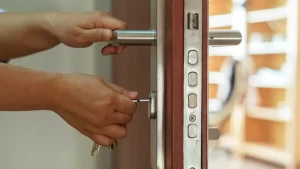Nowadays, many people prioritize the security of their homes. However, for people living with their beloved pets, traditional safety measures may not be enough. It is important to ensure the safety and health of your family and pets by designing a pet-friendly home security system. This complete guide covers the many different aspects of setting up pet-friendly home security.
1. Security Cameras:
Security cameras are the most important part of any home security system. When choosing a camera for a pet-friendly environment, look for one with night vision, motion detection, and two-way audio. Plan where you place your cameras so they can see where your pet spends the most time. You can keep an eye on them this way and it also makes things safer.
The motion detection function can be changed to distinguish between pets and moving people, preventing false alarms. You can talk to your pet remotely and calm him down with two-way audio when he is anxious. Today, cameras can be connected to apps on smartphones, allowing pet owners to keep an eye on their animals and receive alerts in real-time.
2. Smart Doorbell:
For pet-friendly homes, a smart doorbell with a camera and intercom is a great addition to your security system. With these gadgets, you can see and talk to the people at your door from anywhere. This is especially useful for pet owners who need to tell delivery people what to do or greet guests without being physically present.
With real-time alerts and the ability to remotely monitor your front door, you can keep your pets and your home safe. Some smart doorbells can even detect pets and alert you when your furry friend is nearby.
3. Pet Safe Sensors:
Some older motion sensors may not be suitable for pets as they often set off false alarms when pets move around the house. To solve this problem, you may want to use pet-friendly sensors to distinguish between human and pet movements. These sensors use complex algorithms to calculate the size and weight of moving objects. This prevents false alarms from your pet.
Place these sensors in strategic locations where your pet likes to roam and change the sensitivity settings as necessary. This will keep your home security system working without making your pet nervous or causing too many false alarms.
4. Smart Pet Door:
Adding a smart pet door to your home security system gives you more control over where your pets go. You can program these doors to open when certain things happen, such as when a certain pet collar or microchip implant is present. This technology allows pets to come and go as they please, but keeps unwanted guests out.
You can also use a smart pet door with an activity log to keep track of when your pet comes and goes. This feature is very useful to keep an eye on your pets and ensure their safety.
5. Temperature and Environmental Monitoring:
Pets can sense changes in temperature and other conditions in their environment. If you add temperature and environmental sensors to your home security system, you can monitor and change these things from now on. This is especially important for people who leave their pets at home for extended periods.
These sensors can let you know if something goes wrong, such as a sudden temperature increase or damage to your HVAC system. Now that you know this, you can take quick steps to ensure your pet stays in a safe and comfortable place.
6. Interactive Pet Cameras and Treat Dispensers:
Adding interactive pet cameras and treat dispensers to your home security system can help your pets cope with separation anxiety and keep them occupied. When you’re not there, you can see your pets, talk to them, and even give them treats. You can calm your pets and stay connected with them through the many interactive pet cameras with two-way audio.
Some models even come with built-in games and laser pointers that can be controlled remotely, keeping your pet’s mind active. Moreover, it improves their health and makes their homes safer.
7. Emergency Pet Plan:
It is important to have a clear plan for your pet in case of an emergency. This includes providing information on how to contact you in an emergency, how to identify your pet, and safe locations in your home. Be sure to incorporate these pet safety rules into your home security system.
You may also want to use a smart pet collar with GPS tracking. If your pet gets lost or needs to be evacuated, these collars can help you find and return your furry friend quickly.
Conclusion
To create a pet-friendly home security system, you must carefully consider your pet’s needs and how he or she behaves. By using the latest technology, such as smart doorbells, security cameras, pet-friendly sensors, and interactive pet devices, you can make your home and your pets safer and healthier. If you take comprehensive security measures for your home, your pets will be safe and happy even when you are not home.
FAQs
1. What is a home security system for pets?
A pet-friendly home security system is a group of technologies that work together to protect the health and safety of everyone in your home, including pets. To create a safe space, your pet’s specific needs and behavior are taken into account.
2. How can security cameras help pet owners?
Security cameras can monitor pets in real-time, allowing owners to monitor their furry friends remotely. Features like motion detection, night vision, and two-way audio make talking to your pet safer and easier.
3. Explain what smart doorbells are and how pet owners can use them.
The built-in camera and intercom system in a smart doorbell allow homeowners to see and speak to people at the door remotely. This is useful for pet owners who want to tell delivery people what to do or greet visitors without being there in person.
4. What is a pet-safe sensor? Why are they so important?
Pet-friendly sensors are motion detectors that can distinguish between human and pet movements, so pets don’t often send false alarms. Home security systems work better because these sensors use complex algorithms to calculate the size and weight of moving objects.
5. How does a smart pet door help you keep your home safe?
Smart pet doors can provide more control over your pet’s activities by responding to certain signals, such as a microchip or collar. This technology allows pets to enter and leave the house freely but keeps unwanted guests out.
6. Why is it important for pet owners to pay attention to temperature and environment?
Pets can sense changes in temperature and other conditions in their environment. By monitoring these things from a distance, pet owners can ensure their animals are in a safe and comfortable space and take quick action if something goes wrong.



